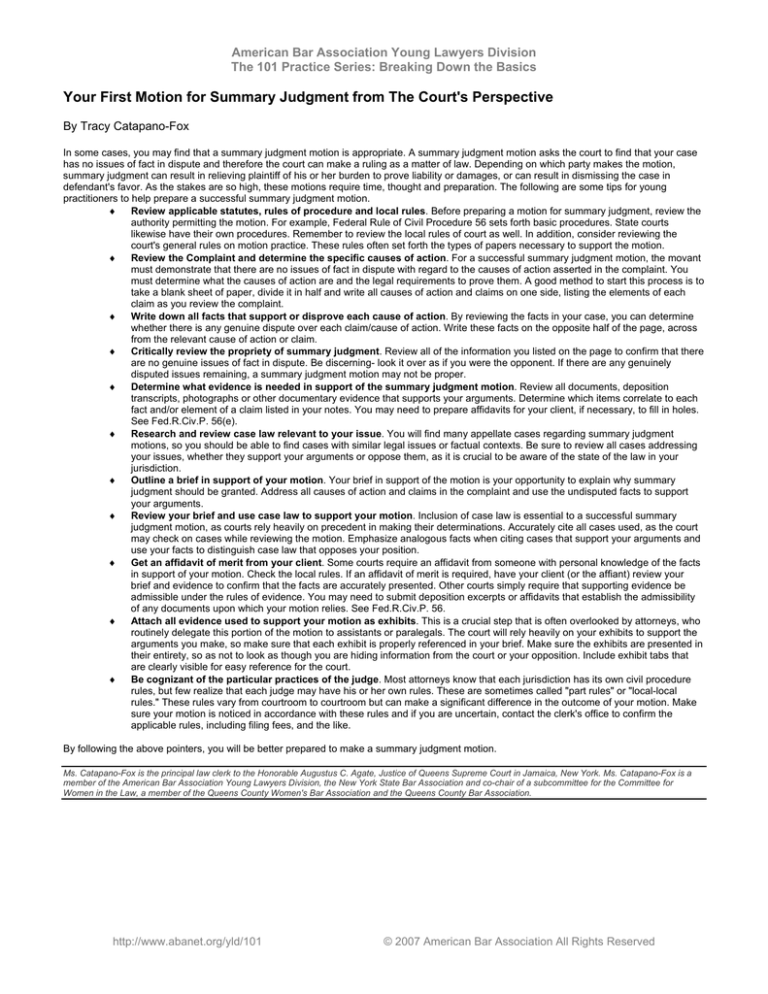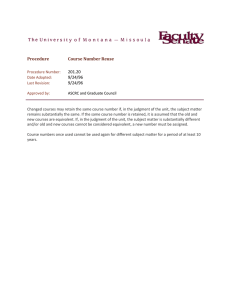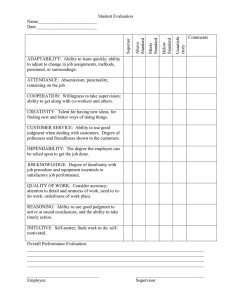
American Bar Association Young Lawyers Division
The 101 Practice Series: Breaking Down the Basics
Your First Motion for Summary Judgment from The Court's Perspective
By Tracy Catapano-Fox
In some cases, you may find that a summary judgment motion is appropriate. A summary judgment motion asks the court to find that your case
has no issues of fact in dispute and therefore the court can make a ruling as a matter of law. Depending on which party makes the motion,
summary judgment can result in relieving plaintiff of his or her burden to prove liability or damages, or can result in dismissing the case in
defendant's favor. As the stakes are so high, these motions require time, thought and preparation. The following are some tips for young
practitioners to help prepare a successful summary judgment motion.
Review applicable statutes, rules of procedure and local rules. Before preparing a motion for summary judgment, review the
authority permitting the motion. For example, Federal Rule of Civil Procedure 56 sets forth basic procedures. State courts
likewise have their own procedures. Remember to review the local rules of court as well. In addition, consider reviewing the
court's general rules on motion practice. These rules often set forth the types of papers necessary to support the motion.
Review the Complaint and determine the specific causes of action. For a successful summary judgment motion, the movant
must demonstrate that there are no issues of fact in dispute with regard to the causes of action asserted in the complaint. You
must determine what the causes of action are and the legal requirements to prove them. A good method to start this process is to
take a blank sheet of paper, divide it in half and write all causes of action and claims on one side, listing the elements of each
claim as you review the complaint.
Write down all facts that support or disprove each cause of action. By reviewing the facts in your case, you can determine
whether there is any genuine dispute over each claim/cause of action. Write these facts on the opposite half of the page, across
from the relevant cause of action or claim.
Critically review the propriety of summary judgment. Review all of the information you listed on the page to confirm that there
are no genuine issues of fact in dispute. Be discerning- look it over as if you were the opponent. If there are any genuinely
disputed issues remaining, a summary judgment motion may not be proper.
Determine what evidence is needed in support of the summary judgment motion. Review all documents, deposition
transcripts, photographs or other documentary evidence that supports your arguments. Determine which items correlate to each
fact and/or element of a claim listed in your notes. You may need to prepare affidavits for your client, if necessary, to fill in holes.
See Fed.R.Civ.P. 56(e).
Research and review case law relevant to your issue. You will find many appellate cases regarding summary judgment
motions, so you should be able to find cases with similar legal issues or factual contexts. Be sure to review all cases addressing
your issues, whether they support your arguments or oppose them, as it is crucial to be aware of the state of the law in your
jurisdiction.
Outline a brief in support of your motion. Your brief in support of the motion is your opportunity to explain why summary
judgment should be granted. Address all causes of action and claims in the complaint and use the undisputed facts to support
your arguments.
Review your brief and use case law to support your motion. Inclusion of case law is essential to a successful summary
judgment motion, as courts rely heavily on precedent in making their determinations. Accurately cite all cases used, as the court
may check on cases while reviewing the motion. Emphasize analogous facts when citing cases that support your arguments and
use your facts to distinguish case law that opposes your position.
Get an affidavit of merit from your client. Some courts require an affidavit from someone with personal knowledge of the facts
in support of your motion. Check the local rules. If an affidavit of merit is required, have your client (or the affiant) review your
brief and evidence to confirm that the facts are accurately presented. Other courts simply require that supporting evidence be
admissible under the rules of evidence. You may need to submit deposition excerpts or affidavits that establish the admissibility
of any documents upon which your motion relies. See Fed.R.Civ.P. 56.
Attach all evidence used to support your motion as exhibits. This is a crucial step that is often overlooked by attorneys, who
routinely delegate this portion of the motion to assistants or paralegals. The court will rely heavily on your exhibits to support the
arguments you make, so make sure that each exhibit is properly referenced in your brief. Make sure the exhibits are presented in
their entirety, so as not to look as though you are hiding information from the court or your opposition. Include exhibit tabs that
are clearly visible for easy reference for the court.
Be cognizant of the particular practices of the judge. Most attorneys know that each jurisdiction has its own civil procedure
rules, but few realize that each judge may have his or her own rules. These are sometimes called "part rules" or "local-local
rules." These rules vary from courtroom to courtroom but can make a significant difference in the outcome of your motion. Make
sure your motion is noticed in accordance with these rules and if you are uncertain, contact the clerk's office to confirm the
applicable rules, including filing fees, and the like.
By following the above pointers, you will be better prepared to make a summary judgment motion.
Ms. Catapano-Fox is the principal law clerk to the Honorable Augustus C. Agate, Justice of Queens Supreme Court in Jamaica, New York. Ms. Catapano-Fox is a
member of the American Bar Association Young Lawyers Division, the New York State Bar Association and co-chair of a subcommittee for the Committee for
Women in the Law, a member of the Queens County Women's Bar Association and the Queens County Bar Association.
http://www.abanet.org/yld/101
© 2007 American Bar Association All Rights Reserved



